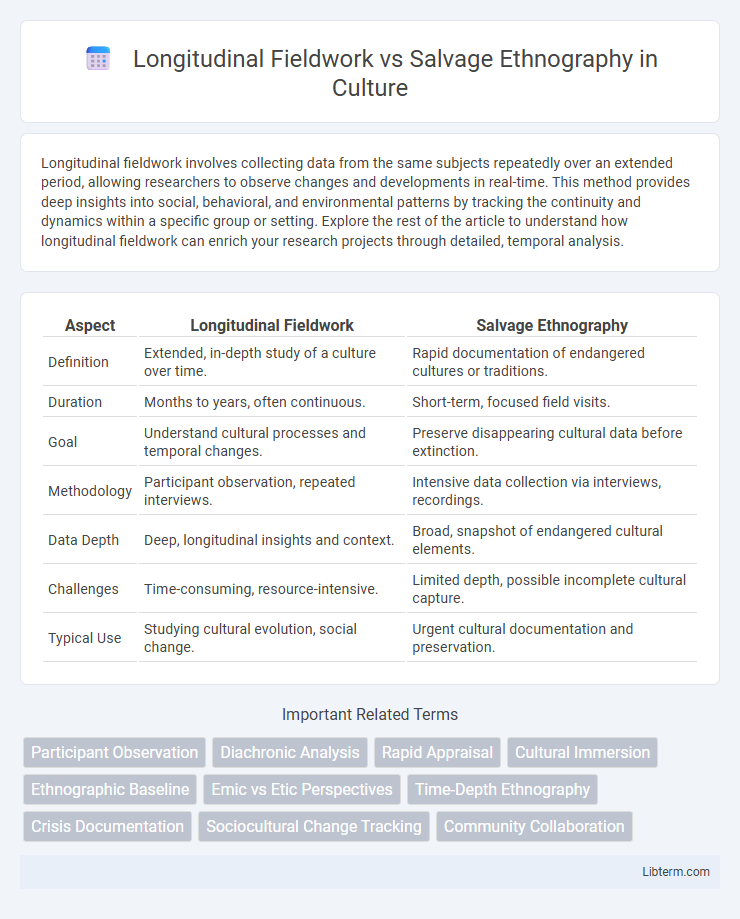Longitudinal fieldwork involves collecting data from the same subjects repeatedly over an extended period, allowing researchers to observe changes and developments in real-time. This method provides deep insights into social, behavioral, and environmental patterns by tracking the continuity and dynamics within a specific group or setting. Explore the rest of the article to understand how longitudinal fieldwork can enrich your research projects through detailed, temporal analysis.
Table of Comparison
| Aspect | Longitudinal Fieldwork | Salvage Ethnography |
|---|---|---|
| Definition | Extended, in-depth study of a culture over time. | Rapid documentation of endangered cultures or traditions. |
| Duration | Months to years, often continuous. | Short-term, focused field visits. |
| Goal | Understand cultural processes and temporal changes. | Preserve disappearing cultural data before extinction. |
| Methodology | Participant observation, repeated interviews. | Intensive data collection via interviews, recordings. |
| Data Depth | Deep, longitudinal insights and context. | Broad, snapshot of endangered cultural elements. |
| Challenges | Time-consuming, resource-intensive. | Limited depth, possible incomplete cultural capture. |
| Typical Use | Studying cultural evolution, social change. | Urgent cultural documentation and preservation. |
Defining Longitudinal Fieldwork
Longitudinal fieldwork involves extended, immersive research conducted over an extended period to observe social processes and cultural changes within a community, allowing for deeper insights into evolving dynamics and relationships. It emphasizes sustained engagement and repeated data collection, which helps to capture continuity and transformation in ethnographic contexts. This contrasts with salvage ethnography, which prioritizes documenting endangered cultures or traditions before they disappear, often through shorter, urgent studies.
Understanding Salvage Ethnography
Salvage ethnography involves the urgent documentation of cultures perceived to be vanishing, emphasizing rapid collection of artifacts, language, and customs before they disappear. It contrasts with longitudinal fieldwork, which studies communities over extended periods to observe cultural changes and continuity. Understanding salvage ethnography requires acknowledging its historical context, methodological limitations, and ethical debates surrounding the portrayal and preservation of indigenous cultures.
Historical Development of Both Approaches
Longitudinal fieldwork emerged as a method in anthropology during the early 20th century, emphasizing extended immersion in a single community to observe social change over time, pioneered by researchers like Bronislaw Malinowski. Salvage ethnography developed concurrently as a response to rapid cultural loss among Indigenous populations, aiming to document and preserve fading customs before they disappeared, with Franz Boas as a key figure. Both approaches reflect historical shifts in anthropological priorities: longitudinal fieldwork focusing on dynamic cultural processes and salvage ethnography prioritizing urgent preservation during times of colonial disruption.
Core Objectives: Comparing Research Goals
Longitudinal fieldwork aims to understand social and cultural changes over extended periods by repeatedly studying the same community or group. Salvage ethnography focuses on documenting and preserving cultures perceived to be rapidly disappearing, often through intensive, short-term research. While longitudinal studies prioritize observing processes and transformations, salvage ethnography emphasizes capturing static cultural traits before they vanish.
Methodological Differences
Longitudinal fieldwork involves immersive, extended engagement with a community over time, allowing researchers to observe social changes and cultural continuity in real-time through repeated interactions and data collection. Salvage ethnography prioritizes rapid documentation of endangered cultures or practices before they disappear, often relying on intensive, short-term field visits and urgent recording methods. Methodologically, longitudinal fieldwork emphasizes temporal depth and participant observation, while salvage ethnography focuses on capturing static cultural artifacts and rituals using archival recordings, photographs, and interviews.
Ethical Considerations in Both Methods
Longitudinal fieldwork emphasizes sustained, respectful relationships with community members, prioritizing informed consent and ongoing ethical reflection to minimize harm and ensure cultural sensitivity. Salvage ethnography often faces ethical challenges related to extracting and preserving cultural data from communities under threat, raising concerns about exploitation and the potential loss of agency among participants. Both methods require balancing the need for knowledge preservation with respect for indigenous rights, autonomy, and the ethical implications of representation.
Data Collection Techniques: A Comparative Overview
Longitudinal fieldwork involves extended, immersive data collection over months or years, utilizing participant observation, repeated interviews, and continuous ethnographic engagement to capture cultural changes and individual life histories. Salvage ethnography focuses on rapid data gathering methods, such as structured interviews, artifact collection, and audio-visual recordings, aimed at preserving endangered cultural practices before they disappear. Both approaches prioritize detailed qualitative data, but longitudinal fieldwork emphasizes temporal depth, while salvage ethnography stresses urgent documentation and preservation.
Strengths and Limitations of Each Approach
Longitudinal fieldwork excels in capturing cultural change and continuity over extended periods, providing in-depth, dynamic insights and fostering strong researcher-community relationships but demands significant time and resources. Salvage ethnography is invaluable for documenting endangered cultures rapidly, preserving valuable data before potential loss, yet it often results in fragmented, less contextualized accounts that may overlook ongoing cultural transformations. Both methods contribute uniquely to anthropology, with longitudinal fieldwork emphasizing depth and process, while salvage ethnography prioritizes urgent cultural preservation.
Impact on Anthropological Knowledge
Longitudinal fieldwork provides a deep temporal perspective by continuously studying the same community over extended periods, allowing anthropologists to observe social, cultural, and environmental changes and their nuanced impacts. Salvage ethnography, often conducted rapidly to document cultures perceived as endangered, captures valuable but static snapshots that risk oversimplifying complex social dynamics and reinforcing stereotypes. The comparative impact on anthropological knowledge lies in longitudinal fieldwork's ability to reveal evolving cultural processes, while salvage ethnography primarily preserves immediate cultural artifacts and practices before potential disappearance.
Choosing the Right Approach for Contemporary Studies
Longitudinal fieldwork offers in-depth insights through extended observation, capturing cultural transformations over time, making it ideal for studying evolving social phenomena. Salvage ethnography prioritizes recording endangered cultures and traditions quickly before they disappear, suitable for documenting at-risk communities facing rapid change or loss. Selecting the right approach depends on research goals: prioritize longitudinal methods for dynamic, ongoing cultural shifts, while salvage ethnography is effective when immediate preservation of cultural knowledge is critical.
Longitudinal Fieldwork Infographic

 libterm.com
libterm.com